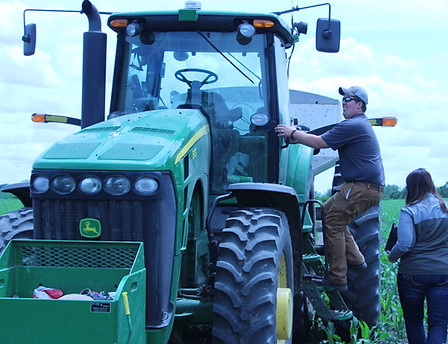MORE YIELD WITHOUT MORE NITROGEN
STORY BY JIM RUEN for NewGround
Justin Krell is getting the best of both worlds - higher yields without buying more nitrogen while being a good steward of soil and water. The Blooming Prairie area farmer and LG Seeds technical team agronomist is a strong advocate of programs that have helped him do better in all three areas. He gives a lot of credit for his progress to his local CFS retailer and its agronomist Ashley Schmeling.
"I'm now in my 10th year with the CFS Central Advantage program," says Krell. "It is what really got me started improving my nutrient utilization. It introduced me to variable rate fertilizer applications and later to prescription seeding at variable rates."
Krell is not alone with his appreciation for CFS Central Advantage. Schmeling reports that the program, in its 17th year, has enrolled 210 growers, improving nutrient utilization efficiency on more than 240,000 acres in the co-op’s territory. Unlike many retailer offered programs, co-op members are not required to buy product to qualify.

Blooming Prairie farmer Justin Krell (left) credits a strong working partnership with CFS agronomist Ashley Schmeling (right) and the CFS Central Advantage program for helping him greatly improve nutrient efficiency on his land over the past decade.
"Our co-op made a major investment in the program, with an 11-person precision ag staff," says Schmeling. "All of us work directly with growers like Justin. CFS wouldn't have the history it does with this program if we didn't believe it helps growers do the right thing."
Schmeling describes Central Advantage as a toolbox of precision agriculture technologies. "Justin is into just about every tool," she says. "Land O'Lakes Sustain's TrueTerra Insights Engine is an element of Central Advantage. It measures how sustainable a piece of ground is and guides the farmer in being more sustainable. It helped Justin and his father Rodney qualify for the Minnesota Agricultural Water Quality Certification Program (MAWQCP).
"MAWQCP is a voluntary opportunity offered by the Minnesota Department of Agriculture for farmers and agricultural landowners to take the lead in implementing conservation practices that protect water. Those who implement and maintain approved farm management practices and are certified obtain regulatory certainty for a period of ten years.

Schmeling helps Krell interpret information produced by Central Advantage tools, which track everything he does on his farm. The tools also provide a report card he can show people who want to learn about his impact on local watersheds.
"I know our generation of farmers is under the microscope for how we farm, and I want to do the best I can," says Krell. "We have to be able to make money, but we also have to be environmentally responsible.
"Krell knows that the Central Advantage tools track everything he does on his farm and provides a report card he can show anyone questioning his impact on local watersheds. With fields draining into three different watersheds, including the Cedar River watershed, he is especially concerned about nitrogen (N) utilization. Thus it is not surprising Central Advantage's Nitrate Now is a favorite tool.
"Nitrate Now has been a game-changer for saving us money while reducing nitrate loss without sacrificing yields," says Krell.
Under the program, CFS lines up sampling on Krell's cornfields at V3 to take 6 inch deep soil cores on 4.4-acre grids. This is in addition to grid sampling for other nutrients once every four years. CFS reports nitrate levels in parts per million. Fields are broken into A, B and C zones with A being highest productivity and C lowest A variable rate prescription is developed for a sidedress application. This is in addition to 2 by 2 starter placement at planting and liquid N added to Krell's pre-emerge herbicide pass. The three passes - in furrow, pre-emerge and sidedress - spoon-feed his crop and allow him to adjust to the year. If needed, he can also inject N into the center pivots on lighter soil on 400 acres of the operation. Section controls allow him some rate variability with them as well.

CFS programs and Schmeling's availability for consultation over time has helped Krell and his father implement and stay with a nutrient management program that's improved precision anprofitability in both operations.
"When we started with Nitrate Now, we were at 0.9 pounds of N per bushel of corn yield," says Krell. "Since then our lowest rate was 0.6 pounds. Normally we are around 0.75. This year we will likely be at 0.8 or a little higher.
"While CFS offers variable rate application services, Krell and his father do their own applications on their respective 800-acre operations. "We share equipment and management ideas, but farm separately," says Krell. "I'm 100 percent strip till, so I put my phosphorous and potash plus sulfur down in the fall using 50 to 60 percent what I would broadcasting."
Krell doesn't limit his sustainability efforts to nutrient applications. Center pivot use is determined with the help of in-ground sensors. Over the past two years he has also begun adding cover crops to his canning crops, winter wheat, corn and soybean rotation. This has allowed him to try planting corn and soybeans green, something he admits was a struggle this past spring due to the frequent rains and late planting.
Nitrate testing, variable rate nutrient applications and other elements of the Central Advantage program, as well as cover crops and moisture sensing, are all part of Krell's overall objective.
"Raising corn and soybeans the same way it has always been done, we had run out of ideas on how to be more profitable and better manage inputs," says Krell. "With Central Advantage tools like Nitrate Now and TrueTerra Insights Engine, we can use data produced on our farms tolearn and improve our ROI. At the same time, we are more responsible with our inputs."